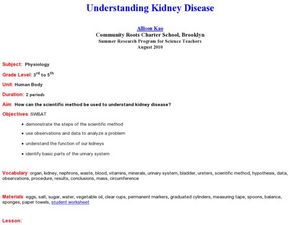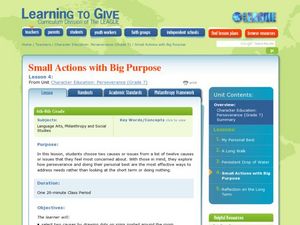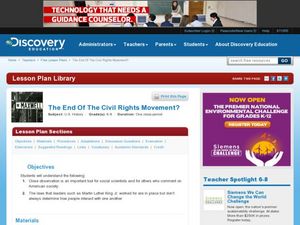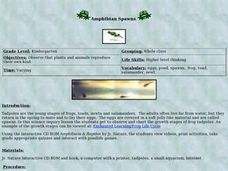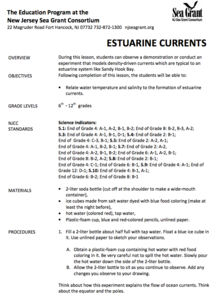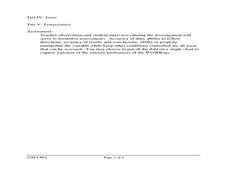Curated OER
Understanding Kidney Disease
Students experiment to determine information about kidney function. In this kidney function lesson, students use the scientific method to experiment with eggs, water, salt, sugar, and vegetable oil to simulate kidney function. They...
Curated OER
What Does the Inside of a Seed Look Like?
First graders study seeds. In this biology lesson, 1st graders observe the differences between dry and wet seeds and draw what is inside a seed after peeling off the outer coat of one of the seeds.
Curated OER
Causal Patterns in Ecosystems Section 3
Students design and create a worm and worm free compost tanks for observation of decay in ecosystems. They make predictions, care, and revist tanks using their journals for observation and data collection.
Curated OER
Density Phenomena-Using the Concept of Density
Students investigate the concept of density by observing demonstrations. In this density lesson plan, students make observations while the teacher demonstrates the Cartesian diver, a density column, a candle trough, a wave bottle, an...
Curated OER
Chemical Composition of American Coins
Students investigate the chemical composition of pennies dated 1983 or later. In this chemical composition of American coins lesson plan, students scratch the surface of the penny to expose the zinc core. They put the penny in...
Curated OER
Mollusk Matching
Students look carefully at shells and observe the differences between
species and the names of common shells. Then they identify and complete a Mollusk Matching handout included in the lesson and write the letter of each shell in the...
Curated OER
Desert Adaptations
In this desert adaptations worksheet, students are given a water filled sponge which represents an animal. Students observe their "animal" for a 24 hour period and conserve the water in the sponge as best they can. They measure and...
Curated OER
Planting Pumpkins
Students plant pumpkins. In this agriculture lesson plan, students use pumpkin seeds, mulch, and shovels to plant seeds from a pumpkin. Students observe the changes during each season.
Curated OER
Small Actions with Big Purpose
Seventh graders examine the trait of perseverance. In this character education lesson, 7th graders discuss community causes they care about and make plans to contribute their time and energy to overcome their personally-selected issues.
Curated OER
Mystical Membrane
High schoolers investigate osmosis, diffusion and a semi-permeable membrane. In this cell membrane lesson plan, students observe the movement of molecules out of a bag filled with sugar and starch into a beaker of water. They test the...
Curated OER
The End of the Civil Rights Movement
Students examine the relationships between blacks and whites in their community. In this racial discrimination lesson plan, students make race relations observations within their community and then write letters that reveal their...
Curated OER
Camouflage
Students observe first hand what it is like to be the prey and what he or she must do to blend in and make themselves less noticeable. They participate in a variety of hands-on activities which help them explain how insects hide...
Curated OER
What's Outside the Cell Membrane ?
Students examine the cell coats (matrix) of chondrocytes and fibroblasts and observe these cells actively exclude particles which are released around them. They observe the function of the cell membrane as a gatekeeper as it prevents...
Curated OER
Human Epidermal Cells
Students explore epidermal cells. After following specified procedures for removing epidermal cells from their wrist, students view the cells with the use of a microscope. After creating a drawing of their observation, students label the...
Curated OER
Specialty Crop Production/Orchids
Twelfth graders explore the fascinating world of orchid production including propagation, care, culture, and finishing. They complete market research and design a production schedule for an orchid crop of their choice. They write a short...
Curated OER
Viewing Bacteria
Young scholars investigate the characteristics harmful and helpful bacteria and observe structures within the bacterial cells. They use micro-slide viewers to observe the shapes of various bacteria and the structures within the bacterial...
Curated OER
Conservation of Mass
In this conservation of mass worksheet, students experiment with vinegar, baking soda, a balloon and a flask. They compare the mass of the closed system of reactants before the experiment to the mass of the products after the experiment...
Curated OER
Hatching chickens
Students recognize the need for gentle care of eggs. In this chicken hatching lesson, students observe the process of incubating eggs for hatching. Students find the materials needed to properly care for the chicks. Students complete a...
Curated OER
Why Not Adopt? Lesson #4
Learners discuss the benefits of pet adoption. In this pet instructional activity, students participate in a class discussion on pet adoption, animal shelters and how to care for a pet. They complete worksheets in groups and write about...
Curated OER
Amphibian Spawns
Students observe tadpoles as they gradually change into adults. In this amphibian biology lesson, students watch tadpoles in a tank in the classroom, keep a daily record of what they observe, and chart the growth development of the...
Curated OER
Estuarine Currents
Students experiment observing a demonstration on models of density-driven currents which are typically found in an estuarine system of water flow. They compare/contrast water temperature and salinity to the formations of estuarine currents.
Curated OER
States of Matter For Grades Kg-8
Students conduct studies of states of matter. For this science lesson plan, students observe the properties of matter and classify different substances as solids, liquids, and gases.
Curated OER
The Nature of Science and Technology
Second graders perform a variety of experiments to observe, form conclusions, and make inferences. In this experiment lesson, 2nd graders experiment based on the result of a pre-assessment. Students share what they have learned.
Curated OER
Relating Maya
Students read about the bags that the Maya people made and about how reusing bags can help save our environment. In this environment lesson plan, students read and discuss conservation and observe pictures.
